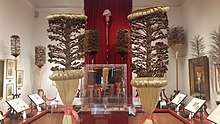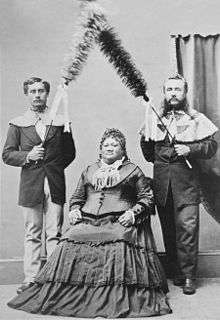Kāhili
A kāhili is a symbol of the aliʻi chiefs and families of the Hawaiian Islands. It was taken by the Kamehamehas as a Hawaiian royal standard and used by the Royal Families to indicate their lineage.
%2C_Nahiennaena_(1825).jpg)

History
The kāhili has long been a symbol of the Hawaiian aliʻi chiefs and the noble houses of the Hawaiian Islands. A kāhili bearer (paa-kahili ) is one who carries or bears the standard for the royal subject.[1] The kāhili signified power from the divinities. The Ali'i surrounded themselves with the standard. It was made using the long bones of an enemy king and decorated with the feathers from birds of prey.[2] The Royal Coat of Arms of the Kingdom of Hawaii depicts the twin Kameʻeiamoku holding a feather standard. Among the pieces collected on Captain Cook's voyages were numerous feathered artifacts including 7 kāhili of the normal design before European influence.[3] In 1825 while aboard the visiting ship returning the remains of Kamehameha II from England, Robert Dampier painted a portrait of Princess Nāhiʻenaʻena holding the royal feather standard.[4]
The Bishop Museum, which was founded in 1889 has an extensive collection of feathered standards on display along with portraits of the monarchs of the 19th century.[5][6] Their collection is displayed in the "Kāhili Room".[7]
Kāhili bearer

Only the ali'i had the right to possess kāhili; It was considered a staff of state. A paa-kahili (kāhili bearer) followed the king everywhere he went. The standard could be used as a fly-brush and waved over the sleeping noble.[8] A ha'aku'e was a kāhili bearer of the same sex as the person they served.[9] The role was similar to that of a squire or page.[10]
Funeral rites
The hana lawelawe of the paa-kahili is an important ritual duty at the funeral of a Hawaiia noble's funeral.[11] From the time the body is laid out to the moment it is interred, the bearers wave the kāhili above the deceased. Three of four kāhili bearers stand on either side and at regular intervals raise the standards above the body until they meet the opposing feathered staff on the other side. The standards are then waved to the right, left and then up while genealogy chants are sung detailing the deeds of the figure and their ancestors. When the body is transported from the home to the church, the hearse is surrounded by kāhili bearers. Once at the chapel the ritual continues, as well as while transferring the deceased to the cemetery.[12] At Bernice Pauahi Bishop's funeral, 150 black kāhili were carried and displayed.[13]
Crafting
Feather crafting is something that was brought to the islands from the first Polynesian voyagers, however, Hawaii has the most advanced examples. The feathers of small birds that were held in high regard for their religious significance were used in crafting a number of the regalia of the Hawaiian chiefs.[14] The ʻahu ʻula, mahiole, kahili and other objects of the aliʻi were made with these sacred feathers.[15][16] A skilled craftsman would be used to create these specific items.[17] The craft was a strong hereditary bond and was passed to younger generations from older experts.[18] The poʻe hahai manu were the expert feather gatherers and would spend months in collection hunts in the forest. Collecting the feathers would sometimes be done for generations.[14]
See also
References
- Mary Kawena Pukui (1 January 1986). Hawaiian Dictionary: Hawaiian-English, English-Hawaiian. University of Hawaii Press. pp. 112–. ISBN 978-0-8248-0703-0.
- Valerio Valeri (15 June 1985). Kingship and Sacrifice: Ritual and Society in Ancient Hawaii. University of Chicago Press. pp. 152–. ISBN 978-0-226-84560-9.
- Thane K. Pratt (2009). Conservation Biology of Hawaiian Forest Birds: Implications for Island Avifauna. Yale University Press. pp. 62–. ISBN 978-0-300-14108-5.
- Ruth M. Tabrah (17 December 1984). Hawaii: A History. W. W. Norton. pp. 49–. ISBN 978-0-393-24369-7.
- Let's Go Inc (28 November 2006). Let's Go Hawaii 4th Edition. St. Martin's Press. pp. 110–. ISBN 978-0-312-36090-0.
- Bonnie Birmingham (1 April 2007). DK Eyewitness Travel Guide: Hawaii. Dorling Kindersley US. pp. 68–. ISBN 978-0-7566-5049-0.
- Top 10 Honolulu & Oahu. DK Publishing. 2 April 2012. pp. 10–. ISBN 978-0-7566-9420-3.
- Davida Malo (1903). Hawaiian Antiquities: (Moolelo Hawaii). Hawaiian islands. pp. 107–.
- Harold Winfield Kent (1993). Treasury of Hawaiian Words in One Hundred and One Categories. University of Hawaii Press. pp. 250–. ISBN 978-0-8248-1604-9.
- Men of ancient Hawai'i. Anima Gemella Co. 1975.
- Kanalu G. Terry Young (25 February 2014). Rethinking the Native Hawaiian Past. Routledge. pp. 153–. ISBN 978-1-317-77669-7.
- Charles Chipman (1901). Honolulu, the Greatest Pilgrimage of the Mystic Shrine. C. Chipman. pp. 249–.
- Samuel P. King; Randall W. Roth (1 January 2006). Broken Trust: Greed, Mismanagement, And Political Manipulation at America's Largest Charitable Trust. University of Hawaii Press. pp. 28–. ISBN 978-0-8248-3044-1.
- Noel Morata. "Ka Hana No'eau i ka Hulu: "The Art of the Feather"". Archived from the original on October 13, 2014. Retrieved October 12, 2014.
- Elizabeth M. Brumfiel; Timothy K. Earle (1 January 1987). Specialization, Exchange, and Complex Societies. Cambridge University Press. pp. 69–. ISBN 978-0-521-32118-1.
- DK Publishing (1 April 2010). Top 10 Honolulu & Oahu. DK Publishing. pp. 46–. ISBN 978-0-7566-6041-3.
- Timothy K. Earle (20 March 2002). Bronze Age Economics: The Beginnings of Political Economies. Westview Press. ISBN 978-0-8133-3877-4.
- Costin; Rita P. Wright (1998). Craft and Social Inquiry. Wiley. ISBN 978-0-913167-90-8.
External links
![]()